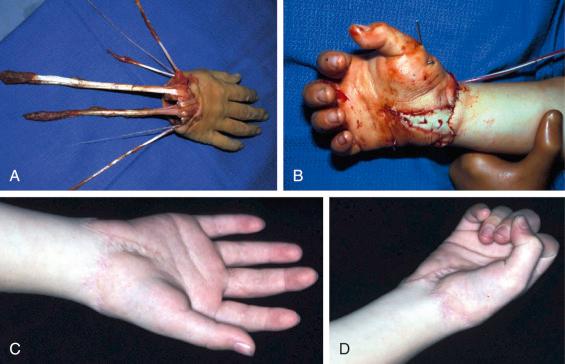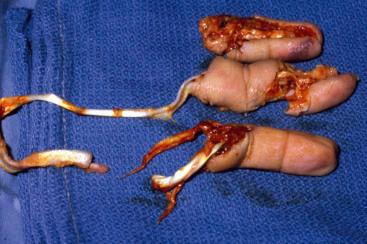Physical Address
304 North Cardinal St.
Dorchester Center, MA 02124
Replantation is the reattachment of a completely amputated part, and revascularization refers to the restoration of blood flow to an incompletely amputated part with vascular compromise, regardless of the size of the bridging tissue attachment. In 1962, the first successful replantation was performed by Malt and McKhann at the Massachusetts General Hospital; the case involved an above-elbow amputation in a 12-year-old boy. Kleinert and colleagues reported the first microvascular anastomosis of digital arteries in 1963, and the first successful digit replantation (a thumb) was performed by Kamatsu and Tamai in 1965. Since that time, replantation has been adopted widely in specialized centers throughout the world.
Each patient must be assessed individually, but good candidates for replantation are those with amputations of the thumb, multiple digits, digits distal to the flexor digitorum superficialis (FDS) insertion, at the palm at the metacarpal level, the wrist or forearm, or any part in a child. Minimally contaminated tissues and guillotine-type injuries are also favorable factors ( Box 51.1 ).
Amputated part in a child
Thumb
Multiple digits
Individual digit distal to flexor digitorum superficialis (FDS) insertion
Transmetacarpal level
Wrist or forearm level
Special consideration should be made for a patient with a thumb amputation because of the functional importance of the thumb, particularly when amputated at a level proximal to the proximal half of the proximal phalanx.
Patients with multiple-digit amputations are candidates either for homotopic or, alternately, heterotopic replantation if the least injured digits and the least injured position on the hand do not correspond. Salvage of as many digits as possible should be considered particularly when taking into consideration that postoperative survival is not 100%.
Digits replanted distal to the FDS insertion generally function well and have good sensory recovery. For very distal replantations (distal to the lunula), several authors report successful replantation of digits with artery-only anastomoses. Generally, dorsal veins are found at a level proximal to the lunula.
Replantation at the metacarpal level can achieve good functional results ( Fig. 51.1 ). Replantation at the level of the wrist or forearm is usually superior to results obtained with a prosthesis, and although extrinsic function is often maintained, the return of intrinsic function is unpredictable ( Fig. 51.2 ).


Additionally, although the success of replantation in children is often less than that of adults due to the technical difficulties of smaller-caliber vessels and a tendency for postoperative vasospasm, when successful, the results are superior to those in adults. On average, the bone growth is 95% and 93% of the digit proximal and distal to the amputation site, respectively; however, some patients demonstrate overgrowth postoperatively.
Absolute contraindications include other life-threatening injuries to the patient, severe crush injuries or degloving injuries to the amputated part ( Fig. 51.3 ), or multilevel amputations ( Box 51.2 ).

Severe associated trauma
Severe systemic illness
Multiple segmental injuries within amputated part or complete crush of amputated part
Single digit proximal to flexor digitorum superficialis (FDS) insertion, particularly border digit
Prolonged ischemia, particularly warm ischemia
Avulsion injuries
Atherosclerotic vessels
Mentally unstable patients
Massive contamination
Relative contraindications include prolonged warm or cold ischemia; although there are reports of successful replantation after 42 hours of warm ischemia or 94 hours of cold ischemia, these are the exception rather than the rule. In general, 2 hours of warm ischemia decreases the success of replantation, and it is greatly reduced after 6 hours of cold ischemia. Age alone has been shown not to be a contraindication for replantation, with no differences in perioperative complications or mortality for patients solely based on age, but one must consider that nerve regeneration will be decreased in the elderly population, and stiffness of the affected digit and adjacent digits is also a concern. Comorbidities must be taken into consideration for all patients because infirm patients may not tolerate the prolonged anesthesia necessary or be able to comply with postoperative therapy. This is particularly true for patients with mental instability.
Preoperative smoking status does not affect success, but patients must be aware that they cannot smoke postoperatively. Postoperative smoking does increase the failure rate of replantation. Experimentally, after one cigarette, flow decreases in the digits by 8%, and after two cigarettes, by 19% secondary to vasospasm.
Replantation of a single digit proximal to the FDS insertion is rarely indicated, particularly of the border digits because of the functional limitations postoperatively and the quadriga effect.
Become a Clinical Tree membership for Full access and enjoy Unlimited articles
If you are a member. Log in here